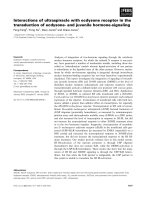ADVANCES IN QUANTITETIVE ANALYSIS OF FINANCE AND ACCOUNTING Volume 1 pdf
Bạn đang xem bản rút gọn của tài liệu. Xem và tải ngay bản đầy đủ của tài liệu tại đây (1.96 MB, 235 trang )
ADVANCES IN QUANTITATIVE ANALYSIS OF
FINANCE AND
ACCOUNTING
New Series
Advances in Quantitative Analysis of Finance and Accounting (New Series)
Editorial Board
Cheng F. Lee
Mike J. Alderson
James S. Ang
K. R. Balachandran
Thomas C. Chiang
Thomas W. Epps
Thomas J. Frecka
Robert R. Grauer
Puneet Handa
Der-An Hsu
Prem C. Jain
Jevons C. Lee
Wayne Y. Lee
Scott C. Linn
Gerald J. Lobo
Yaw Mensah
Thomas H. Noe
Oded Palmon
Louis O. Scott
Andrew J. Senchak
David Smith
K. C. John Wei
William W. S. Wei
Chunchi Wu
Uzi Yaari
Rutgers University, USA
University of St. Louis, USA
Florida State University, USA
New York University, USA
Drexel University, USA
University of Virginia, USA
University of Notre Dame, USA
Simon Fraser University, Canada
University of Iowa, USA
University of Wisconsin, Milwaukee, USA
Georgetown University, USA
Tulane University, USA
Kent State University, USA
University of Oklahoma, USA
University of Houston, USA
Rutgers University, USA
Tulane University, USA
Rutgers University, USA
Morgan Stanley Dean Witter, USA
University of Texas, Austin, USA
Iowa State University, USA
Hong Kong Technical University, Hong Kong
Temple University, USA
Syracuse University, USA
Rutgers University, USA
ADVANCES IN QUANTITATIVE ANALYSIS OF
FINANCE AND
ACCOUNTING
New Series
Editor
Cheng-Few Lee
Rutgers University, USDA
rp World Scientific
NEW JERSEY LONDON SINGAPORE SHANGHAI - HONG KONG - TAIPEI BANGALORE
Published by
World Scientific Publishing Co. Pte. Ltd.
5 Toh Tuck Link, Singapore 596224
USA office: 27 Warren Street, Suite 401-402, Hackensack, NJ 07601
UK office: 57 Shelton Street, Covent Garden, London WC2H 9HE
British Library Cataloguing-in-Publication Data
A catalogue record for this book is available from the British Library.
ADVANCES IN QUANTITATIVE ANALYSIS OF FINANCE AND ACCOUNTING
(NEW SERIES) VOLUME 1
Copyright © 2004 by World Scientific Publishing Co. Pte. Ltd. and Cheng-Few Lee
All rights reserved. This book, or parts thereof, may not be reproduced in any form or by any means,
electronic or mechanical, including photocopying, recording or any information storage and retrieval
system now known or to be invented, without written permission from the Publisher.
For photocopying of material in this volume, please pay a copying fee through the Copyright
Clearance Center, Inc., 222 Rosewood Drive, Danvers, MA 01923, USA. In this case permission to
photocopy is not required from the publisher.
ISBN 981-238-669-6
Typeset by Stallion Press
Email:
Printed in Singapore.
Preface to Volume 2
Advances in Quantitative Analysis of Finance and Accounting (New Series) is
an annual publication designed to disseminate developments in the quantitative
analysis of finance and accounting. It is a forum for statistical and quantitative analyses of issues in finance and accounting, as well as applications of
quantitative methods to problems in financial management, financial accounting and business management. The objective is to promote interaction between
academic research in finance and accounting, applied research in the financial
community, and the accounting profession.
The chapters in this volume cover a wide range of topics including derivatives pricing, hedging, index securities, asset pricing, different exchange trading, knowledge spillovers and analyst performance and voluntary disclosure.
In this volume, there are 12 chapters. Five of them are related to stock
exchange trading, index securities and hedging: 1. Intraday Trading of Island
(As Reported to the Cincinnati Stock Exchange) and NASDAQ; 2. The Impact
of the Introduction of Index Securities on the Underlying Stocks: The Case of
the Diamonds and the Dow 30; 3. Hedging with Foreign-Listed Single Stock
Futures; 4. Listing Switches from NASDAQ to the NYSE/AMEX: Is New York
Issuance a Motive? 5. Using Path Analysis to Integrate Accounting and NonFinancial Information: The Case for Revenue Drives of Internet Stocks.
Two of the 12 chapters are related to derivatives securities. 1. Multinomial
Lattices and Derivatives Pricing; 2. Is Covered Call Investing Wise? Evaluating
the Strategy Using Risk-Adjusted Performance Measures
The other two of the 12 chapters are related to analysts’ earnings forecast:
1. Voluntary Disclosure of Strategic Operating Information and the Accuracy of
Analysts’ Earnings Forecast; 2. CFA Designation, Geographical Location and
Analyst Performance. Finally, the other three papers are 1: Value-Relevance of
Knowledge Spillovers: Evidence from Three High-Tech Industries; 2. A Teaching Note on the Effective Interest Rate, Periodic Interest Rate and Compounding
Frequency; 3. Asset Pricing with Higher Moments: Empirical Evidence from
the Taiwan Stock Market.
v
This page intentionally left blank
Contents
Preface to Volume 2
List of Contributors
v
ix
Chapter 1
Multinomial Lattices and Derivatives Pricing
George M. Jabbour, Marat V. Kramin, Timur V. Kramin,
Stephen D. Young
1
Chapter 2
Value-Relevance of Knowledge Spillovers: Evidence
from Three High-Tech Industries
Michael K. Fung
Chapter 3
Chapter 4
Chapter 5
Chapter 6
Using Path Analysis to Integrate Accounting and
Non-Financial Information: The Case for Revenue
Drives of Internet Stocks
Anthony Kozberg
A Teaching Note on the Effective Interest Rate,
Periodic Interest Rate and Compounding Frequency
Youngsik Kwak, H. James Williams
Voluntary Disclosure of Strategic Operating
Information and the Accuracy of Analysts’ Earnings
Forecasts
Sidney Leung
Intraday Trading of Island (As Reported to the
Cincinnati Stock Exchange) and NASDAQ
Van T. Nguyen, Bonnie F. Van Ness,
Robert A. Van Ness
vii
17
33
65
73
89
viii Contents
Chapter 7
The Impact of the Introduction of Index Securities
on the Underlying Stocks: The Case of the
Diamonds and the Dow 30
Bonnie F. Van Ness, Robert A. Van Ness,
Richard S. Warr
105
Chapter 8
Hedging with Foreign-Listed Single Stock Futures
Mao-wei Hung, Cheng-few Lee, Leh-chyan So
Chapter 9
Asset Pricing with Higher Moments: Empirical
Evidence from the Taiwan Stock Market
Bing-Huei Lin, Jerry M. C. Wang
153
Listing Switches from NASDAQ to
the NYSE/AMEX: Is New York Issuance a Motive?
Asli Ascioglu, Thomas H. McInish
171
Is Covered Call Investing Wise? Evaluating
the Strategy Using Risk-Adjusted Performance Measures
Karyl B. Leggio, Donald Lien
187
CFA Designation, Geographical Location and
Analyst Performance
Ping Hsiao, Wayne Y. Lee
205
Chapter 10
Chapter 11
Chapter 12
Index
129
219
List of Contributors
Chapter 1
George M. Jabbour
The George Washington University
2023 G Street
Room 530
Washington DC, 20052
Tel: 202-994-3879
Fax: 202-994-5110
Email:
Marat V. Kramin
Fannie Mae Portfolio Strategy Department
2500 Wisconsin Avenue, #141
Washington DC, 20007
Tel: 202-752-6383
Email:
Timur V. Kramin
Tatarstan American Investment Fund
AK. Parina St., 12-62
Kazan, Tatarstan, Russia
Stephen D. Young
Wachovia Securities Equity Derivatives Group
5000 Morrowick Road
Charlotte, NC 28226
Tel: 704-715-8215
Email:
ix
x List of Contributors
Chapter 2
Michael K. Fung
Department of Business Studies
Hong Kong Polytechnic University
Hung Hom
Kowloon
Hong Kong
Tel: (852) 2766-7102
Fax: (852) 2653-3947
Email:
Chapter 3
Anthony Kozbergh
Zicklin School of Business
CUNY — Baruch College
PO Box B12-225
New York, NY 10010
Tel: 646-312-3230
Email:
Chapter 4
Youngsik Kwak
Department of Accounting and Finance
School of Management
Delaware State University
Dover, Delaware 19901
Tel: 302-857-6913
Email:
H. James Williams
School of Business
North Carolina Central University
Durham, North Carolina 27707
Tel: 919-530-6458
Email:
List of Contributors xi
Chapter 5
Sidney Leung
Department of Accountancy
City University of Hong Kong
Tat Chee Avenue, Kowloon
Hong Kong
Tel: (852) 2788 7924
Fax: (852) 2788 7944
Email:
Chapter 6
Van. T. Nguyen
University of Mississippi
College of Business, Holman Hall
University, MS 38677
Tel: 662-915-5394
Email:
Bonnie F. Van Ness
University of Mississippi
College of Business, Holman Hall
University, MS 38677
Tel: 662-915-6749
Email:
Robert A. Van Ness
University of Mississippi
College of Business, Holman Hall
University, MS 38677
Tel: 662-915-6940
Email:
Chapter 7
Bonnie F. Van Ness
University of Mississippi
Department of Finance
xii List of Contributors
School of Business Administration
P.O. Box 1848
University, MS 38677
Tel: 662-915-6749
Fax: 662-915-5087
Email:
Robert A. Van Ness
University of Mississippi
Department of Finance
School of Business Administration
P.O. Box 1848
University, MS 38677
Tel: 662-915-6940
Fax: 662-915-5087
Email:
Richard S. Warr
Department of Business Management
College of Management
Box 7229
North Carolina State University
Raleigh, NC 27695-7229
Tel: 919-513-4646
Fax: 919-515-6943
Email:
Chapter 8
Mao-wei Hung
College of Management
National Taiwan University
No. 1, Section 4
Roosevelt Road
Taipei, Taiwan
Email:
Cheng-few Lee
Department of Finance
Rutgers University
List of Contributors xiii
94 Rockafeller Road
Piscataway. NJ 08854
Tel: 732-445-3530
Fax: 732-445-5927
Email:
Leh-chyan So
College of Management
National Taiwan University
No. 1, Section 4
Roosevelt Road
Taipei, Taiwan
Chapter 9
Bing-Huei Lin
Department of Business Administration
National Taiwan University of Science and Technology
No. 43, Section 4
Keelung Road
Taipei 104, Taiwan
Tel: 886-2-2737
Fax: 886-2-2737
Email:
Jerry M. C. Wang
Department of Business Administration
National Taiwan University of Science and Technology
Chapter 10
Asli Ascioglu
Assistant Professor of Finance
Bryant College
1150 Douglas Pike
Smithfield, RI 02917-1284
Tel: 401-232-6873
Email:
xiv List of Contributors
Thomas H. McInish
Professor and Wunderlich Chair of Finance
The University of Memphis
Memphis, TN 38152
Tel: 901-678-4662
Email:
Chapter 11
Karyl B. Leggio
Bloch School of Business and Public Administration
University of Missouri at Kansas City
Kansas City, Missouri 64110
Tel: 816-235-1573
Fax: 816-235-6505
Email:
Donald Lien
College of Business
University of Texas at San Antonio
San Antonio, Texas 78249-0631
Tel: 210-458-7312
Fax: 210-458-5833
Email:
Chapter 12
Ping Hsiao
Department of Finance
College of Business
San Francisco State University
San Francisco, CA 94132
Email:
Wayne Y. Lee
Department of Finance
Sam M. Walton College of Business Administration
University of Arkansas
Fayetteville, AR 72701
Chapter 1
Multinomial Lattices and Derivatives
Pricing
George M. Jabbour*
The George Washington University, USA
Marat V. Kramin
Fannie Mae Portfolio Strategy Department, USA
Timur V. Kramin
Santel, Tatarstan American Investment Fund, Russia
Stephen D. Young
Wachovia Capital Markets, USA
This article elaborates an n-order multinomial lattice approach to value derivative instruments
on asset prices characterized by a lognormal distribution. Nonlinear optimization is employed,
specified moments are matched, and n-order multinomial trees are developed. The proposed
methodology represents an alternative specification to models of jump processes of order greater
than three developed by other researchers. The main contribution of this work is pedagogical.
Its strength is in its straightforward explanation of the underlying tree building procedure for
which numerical efficiency is a motivation for actual implementation.
Keywords: Lattice; multinomial; derivatives; moment matching; numerical efficiency.
1. Introduction
Since the seminal article by Black and Scholes (BS, 1973), numerous methods
for valuing derivative securities have been proposed. Merton (1973) extended
the BS model to include valuing an option on a stock or index that pays continuous dividends. From this framework, the BS model was easily extended
to currency options. In the case of exotic contracts where there is no closed
form solution, various techniques have been elaborated including Monte-Carlo
simulation, numerical integration, analytical and series approximation, jump
∗ Corresponding author.
The views expressed in this article are those of the authors and do not necessarily reflect the
position of Fannie Mae, Santel or Wachovia Securities.
1
2 George M. Jabbour et al.
processes, and finite difference methods. Parkinson (1977) applied a three-jump
model via numerical integration to the valuation of American put options. Brennan and Schwartz (1978) demonstrated that the probabilities of a jump process
approximation to the underlying diffusion process correspond to the coefficients of the difference equation approximation of the BS partial differential
equation. Further, they demonstrated that the trinomial tree is equivalent to
the explicit finite difference method and that a generalized multinomial jump
process is equivalent to a complex implicit finite difference approximation.
Courtadon (1982) suggested an alternative finite difference approximation.
Cox, Ross and Rubinstein (CRR, 1979) and Rendleman and Bartter (RB,
1979) introduced the two-state lattice approach, which proved to be a powerful tool that can be used to value a wide variety of contingent claims. Jabbour, Kramin and Young (2001) generalized the standard binomial approach
and incorporate the main existing models as particular cases of an alternative approach to the specification of these lattices. Geske and Shastri (1985)
compared a variety of approximation methods for contingent claims valuation,
including the efficiency of the binomial lattice approach and finite difference
method for option valuation. A number of alternative analytical approximations for continuous time valuation were suggested by Johnson (1983), Geske
and Johnson (1984), Blomeyer (1986), Macmillan (1986), Whaley (1986),
Barone-Adesi and Whaley (1987), and Omberg (1987). Boyle (1986) introduced a three-jump process as a modification of the CRR model in the case of
a single state variable.
Boyle (1988) extended the lattice approach to option valuation in the case of
two underlying state variables. Boyle’s trinomial model was based on a moment
matching methodology. The mean and variance of the discrete distribution
were equated to those of the continuous lognormal distribution. By introducing a numerically optimized parameter, Boyle ensured non-negativity of the
risk-neutral probabilities. Further, Boyle introduced a two-dimensional fivejump process for pricing options on two underlying assets that follow a bivariate lognormal distribution. This left the three or more state variable question
unanswered. The difficulties associated with the practical implementation of
Boyle’s model to three or more state variables were connected with ensuring non-negative risk-neutral probabilities. Boyle, Evnine and Gibbs (1989)
overcame this problem by equating the moment generating function of the
approximating distribution to the true normal moment generating function.
This technique can be easily generalized to k state variables. Kamrad and
Multinomial Lattices 3
Ritchken (1991) developed a multinomial lattice approximating method for
valuing claims on several state variables that included many existing models as
special cases. For example, the Kamrad and Ritchken (1991) model extended
the model proposed by Boyle, Evnine and Gibbs (1989) offered some computational advantages by incorporating horizontal jump. Hull and White (1988)
suggested a generalized version of the lattice approach to option pricing using a
control variate technique and introduced a multivariate multinomial extension
of the CRR model. Further, Hull and White (1994a, 1994b) proposed a robust
two-stage procedure for one- and two-factor trinomial lattice models. Madan,
Milne and Shefrin (1989) generalized the CRR model to the multinomial case
to approximate a multi-dimensional lognormal process. They showed that the
distribution of the discrete-time process converged to that of a one-dimensional
lognormal process for a number of underlying assets, but they failed to specify
the correlation structure among assets and establish convergence for general
multivariate contingent claims prices. Hua (1990) solved this problem by using
an alternative multinomial multivariate model.
Omberg (1988) derived a number of multinomial jump processes via pure
Gauss-Hermite quadrature. The drawback to this method is that the nodes of
the corresponding multinomial tree of order greater than three are not uniformly spaced (i.e., the tree is not recombining and the number of possible
states increases geometrically with the number of time steps). To overcome
this problem, Omberg (1988) suggested a modified Gauss-Hermite quadrature
technique with uniform jumps and a lower degree of precision using Lagrangian
polynomial interpolation to determine the value of the function at the Gaussian
points.
Heston and Zhou (2000) investigated the rate of convergence of multinomial trees. They showed that the highest possible convergence rate for the
lattice that ensures matching the first K central moments of the underlying
1
stochastic process probability distribution, (√n) K −1 , can be achieved with
certainty only when the payoff of the derivative valued is continuously differentiable up to order 2K (C (2K ) ). This condition is rarely satisfied. To overcome
these difficulties, Heston and Zhou (2000) proposed a smoothing and adjustment approach and implemented them on trinomial and pentanomial lattices.
Alford and Webber (2001) considered numerous techniques related to convergence and processing time improvement: smoothing, and Richardson extrapolation and truncation for multinomial lattices of order (4m − 1), where m is an
integer, to achieve higher convergence rates for payoff functions with a finite
4 George M. Jabbour et al.
set of critical points. This approach allowed one to match up to (4m + 1) central moments of the underlying log-normal distribution. They concluded that
the heptanomial lattice is the fastest and most accurate higher-order lattice.
The focus of the last two papers was the application of multinomial trees to
improve the rate of convergence of lattice methods. This was why Heston and
Zhou (2000) and Alford and Webber (2001) considered numerous techniques
for convergence improvement. Focusing on convergence, they considered only
the lattices of orders 2, 3 and 5, and the latter — 3, 7, 11, 15, 19 etc. Working
in a Black-Scholes world, they initially imposed a symmetry condition (the
odd central moments are zero) on their systems and solved to match the even
central moments consistent with a normal distribution. This is similar to the
methodology specified in this paper.
In the Heston and Zhou (2000) and Alford and Webber (2001) papers, the
methodology is not the focus and is therefore not as fully developed as in
this paper. The purpose of this paper is pedagogical. It provides a step-by-step
description of the moment matching technique, which is applied to develop
n-order multinomial lattice parameterizations for a single-state option-pricing
model. Thus, the underlying methodology is the focus. The remaining format of this paper is as follows. Section 2 provides a general description of
n-order multinomial lattices. Section 3 defines the procedure when the underlying asset is described by a Geometric Brownian Motion process. Section 4
discusses practical implementation and provides numerical results. Section 5
gives conclusions.
2. A General Description of n-Order Multinomial Lattices
Consider a stochastic variable Q that follows an Ito process:
dQ = a(Q, t) dt + b(Q, t) dz,
(1)
where dt is an infinitely small increment of time, dz is a Wiener process, a(Q, t),
b(Q, t) are some functions of Q and t is time. In a multinomial model of order
n, for a short period of time t, the variable Q can move from Q 0 (the value
at time zero) to Q 0 + q j , with j = 1, n, where q j is a change in the value of Q
for time t and n is the number of possible jumps. The change of Q for time
t has the following discrete distribution:
{q j with risk-neutral probability p j }.
Multinomial Lattices 5
For a lattice approach, the first moment (M1 ) of the distribution of the variable
Q is given by the following:
n
M1 =
pj · qj.
(2)
j =1
To apply a moment matching technique and develop an n-order multinomial
framework, one has to equate the first n central moments of the discrete lattice
distribution to those of the specified continuous distribution. In order to match
the first moment of the lattice approach for variable Q with the first moment
consistent with the underlying process, one has to set:
n
M1 =
p j · q j = E(Q t ) = m.
j =1
The kth order central moment of the lattice approach for variable Q can be
given as follows:
n
mk =
˜
n
p j · (q j − m)k =
j =1
p j · zk ,
j
j =1
˜
where z j = q j − m. The first central moment m 1 is zero by construction,
and the second central moment m 2 is set equal to the variance of the variable
˜
Q. To match the remaining central moments, it is necessary to specify the set
of central moments of the variable Q determined by the moment generating
function (MGF) M(t) of the underlying distribution. The central moments of
the distribution can be obtained by applying a Taylor series expansion to the
MGF as follows:
∞
tj
M ( j ) (0)
,
M(t) =
( j !)
j =0
where M ( j ) (0) (the derivative of j order at time zero) represents the j order central moment. In order to set the lattice probability distribution consistent with a
specified underlying distribution, one can apply a moment matching approach
by solving the following nonlinear system with respect to the unknown parameters p j and z j , j = 1, n:
n
Q
p j · zk = mk ,
j
mk =
˜
k = 0,L,
(3)
j =1
Q
where m k is the central moment of order k of the continuous distribution
and L is the number of moments matched. In order to specify the n-order
6 George M. Jabbour et al.
multinomial lattice, it is sufficient to set n + 1 equations, that is, L = n. The
first equation is the condition that the probabilities sum to one. The remaining
n equations match the first n central moments of the discrete distribution to
those of the continuous underlying distribution. Solution vectors [P] = { p j }n =1
j
and [Z ] = {z j }n =1 in this case are not unique because for 2n unknowns there
j
are only n + 1 nonlinear equations. In order to determine the unique solution
{[P], [Z ]}, one has to impose additional constraints. These constraints, if
feasible, will affect only the convergence speed of the lattice model.
3. Multinomial Lattices and Lognormally Distributed
Asset Prices
In a risk-neutral world, if one assumes that the stock price S follows a Geometric
Brownian Motion process (GBM), then:
dS = rS dt + σ S dz,
(4)
where r is the instantaneous risk-free interest rate, and σ is the instantaneous
volatility of the stock price. By using Ito’s Lemma, one can show:
dX = α dt + σ dz,
(5)
where X = ln(S) and α = r − σ2 . As a result, ln(S) follows a generalized
Wiener process for the time period (0, t), where t is a point in time. The variable
St
ˆ
X = X t − X 0 = ln S0 is distributed with a mean of α · t, a variance of σ 2 t and
S0 and St represent the stock price at time 0 and t respectively. In a multinomial
model of order n, the stock price can move from S0 to u j · S0 , j = 1, n, where
u j is a proportional change in stock price for time t and n is the number of
ˆ
possible jumps. The variable X has the following discrete distribution:
2
{q j with risk-neutral probability p j },
where q j = ln(u j ). The first moment of the continuous underlying process for
ˆ
ˆ
variable X is E( X ) = α · t = m. The second moment m 2 is set equal to σ 2 · t.
˜
The moment generating function for a variable R that is normally distributed
R ∼ N (µ, δ) is given by the following:
1
M(t) = eµ·t + 2 ·δ
2 ·t 2
.
Multinomial Lattices 7
Because the normal distribution is symmetrical, all odd central moments are
zero. For the standard normal distribution W,
1
M(t) = e 2 ·t =
2
∞
j =0
t2 j
.
( j !) · 2 j
The (central) moment of order k represents the coefficient before t k in the series
above multiplied by k! and can be given by the following formula:
0
W
mk =
k/2
i=1
(2 · i − 1)
if k is odd
.
if k is even
For example,
W
W
W
W
W
m 1 = 0; m 3 = 0; m 5 = 0; m 7 = 0; m 9 = 0; etc.
W
W
W
W
W
m 2 = 1; m 4 = 3; m 6 = 15; m 8 = 105; m 10 = 945; etc.
Analogously, for the variable R, it can easily be shown that the central moments
are given by the following:
R
mk =
0
k/2
i=1
(2 · i − 1)δ
k
if k is odd
,
if k is even
and:
R
R
R
R
R
m 1 = 0; m 3 = 0; m 5 = 0; m 7 = 0; m 9 = 0; etc.
R
R
R
R
R
m 2 = δ 2 ; m 4 = 3δ 4 ; m 6 = 15δ 6 ; m 8 = 105δ 8 ; m 10 = 945δ 10 ; etc.
The lattice probability distribution consistent with a normal distribution can be
√
q −m
Q
W
obtained by solving the system (3), where m k = m k , z j = j δ , δ = σ t,
j = 1, n, k = 0,L.
To illustrate the moment matching methodology, consider the binomial and
trinomial models. In the first case, n = 2, thus the first two moments should be
matched. In a binomial (two jump process) model, the stock price can either
move up from S0 to u · S0 or down to d · S0 , where u and d are two parameters
such that u is greater than one — to avoid arbitrage it is actually greater than
ert — and d is less than one. Since the stock price follows a binomial process,
ˆ
the variable X has the following discrete distribution:
U with risk-neutral probability p
,
D with risk-neutral probability (1 − p)
8 George M. Jabbour et al.
where U = ln(u) and D = ln(d). For the binomial lattice, the system is given
by the following:
p · U + (1 − p) · D = α ·
t,
p(1 − p)(U − D)2 = σ 2 t.
This system of two equations and three unknowns U , D, and p can be
further specified as follows:
p1 + p2 = 1,
p1 w1 + p2 w2 = 0,
(6)
p1 (w1 ) + p2 (w2 ) = 1,
2
2
√
√
where p1 = p; p2 = 1 − p; w1 = (U −α t t) ; and w2 = (D−α t t) . It should be
σ
σ
noted that a properly specified binomial lattice always results in a recombining
tree. If one imposes the additional constraint that the third central moment
is zero (this is consistent with normally distributed returns and may improve
the convergence of the lattice approach but is not critical for the binomial
model), then
p1 (w1 )3 + p2 (w2 )3 = 0.
(7)
The system (6) and (7) has four equations and four unknowns ( p1 , w1 , p2 , w2 )
and is complete. With constraint (7) the solution is trivial and unique: p1 =
1
p2 = 2 , and w1 = −1, w2 = 1. This solution is equivalent to the specification
of RB (1979) and Jarrow-Rudd (1983). As is well known, the standard binomial framework affords numerous specifications, which are fully discussed in
Jabbour, Kramin and Young (2001).
For a trinomial (three-jump process) model, the system of the moment
matching methodology is given by the following:
p1 + p2 + p3
p1 w1 + p2 w2 + p3 w3
2
p1 (w1 ) + p2 (w2 )2 + p3 (w3 )2
p1 (w1 )3 + p2 (w2 )3 + p3 (w3 )3
= 1,
= 0,
= 1,
= 0.
(8)
The additional constraints can be imposed on the fourth and fifth moments as
follows:
p1 (w1 )4 + p2 (w2 )4 + p3 (w3 )4 = C,
(9)
p1 (w1 ) + p2 (w2 ) + p3 (w3 ) = 0.
(10)
5
5
5
Multinomial Lattices 9
In this case the complete system (8), (9) and (10) has a simple and unique
analytical solution that can be obtained using pure Gauss-Hermite quadrature.
The following is the parameterization of the system:
p1 = p3 =
√
√
1
C−1
, p2 =
, w1 = − C, w2 = 0, w3 = C.
2C
C
(11)
When one specifies the fourth moment of the lattice distribution corresponding
to the fourth moment of the standard normal distribution (the kurtosis is equal to
three, C = 3), the parameterization simplifies to the following as demonstrated
by Omberg (1988):
1
p1 = p3 = ,
6
p2 =
√
√
2
, w1 = − 3, w2 = 0, w3 = 3.
3
(12)
While there is no need to set the particular restrictions given by (9) and (10),
which are consistent with the fourth and fifth moments of the normal distribution, these constraints should improve the convergence of the lattice approach
in the case when payoff smoothness conditions (Heston and Zhou, 2000) are
satisfied. For this case, the recombining condition is given by the following:
w3 − w2 =
2
=
1
= w2 − w1 .
(13)
Therefore, the lattice consistent with the parameterization (11) recombines.
Equation (10) can be considered a constraint that ensures a symmetrical lattice
distribution. Parameter C represents a degree of freedom. The value of this
parameter will not affect convergence to the correct value but rather the rate
of convergence (Heston and Zhou, 2000). It is worth noting that multinomial
trees of order higher than three obtained via pure Gauss-Hermite quadrature
are not recombining. This does not diminish the theoretical importance of the
technique but limits it as a practical method to applying n-order multinomial
trees.
In general, the system for the moment matching approach can be mathematically represented as follows:
W
[P]T [W k ] = m k , k = 0, L,
(14)
where [W k ] = {w k }n =1 , [W 0 ] = {w 0 }n =1 = {1}n =1 = [J ] and [J ] is a unit
j j
j
j j
vector. Analogous to (13), in order to make the n-order multinomial tree recombine, one may impose the following constraints:
j +1
=
j,
j = 1, n − 2,
(15)
10 George M. Jabbour et al.
where i ≡ wi+1 − wi , i = 1, n − 1.1 The nonlinear system (14) and (15) can
be solved with respect to [P] and [W ] numerically.2
Given a proper specification of an n-order multinomial lattice, the value of
an option can be obtained through the usual backward recursion procedure:
n
f = e−r
pk f k = e−r
t
t
· [P]T [F],
k=1
where t is the length of a time step, and [F] = { f j }n =1 represents the value
j
of the option along a number of appropriate nodes of the n-order multinomial
lattice.
4. Practical Implementation and Numerical Results
In this section, the practical implementation of n-order multinomial lattices is
outlined and numerical results are provided. The first step of the approach is to
determine the set of risk-neutral probabilities [P] and jump parameters [W ].
While a number of methods exist to implement this task one may minimize the
following function:
min [P]T [W K ] − m W ,
K
[W ],[P]
(16)
subject to constraints (14) and (15) where K is the minimum even number that
is greater than n.This nonlinear optimization procedure ensures a minimum difference between the K th central moment of the discrete distribution and that of
the continuous distribution for the n-order multinomial model. While one does
not have to specify this procedure to obtain the unknown tree parameters [P]
and [W ] (the satisfaction of constraints (14) and (15) and, perhaps, risk-neutral
probability non-negativity constraints would be enough), the procedure (16)
can accelerate convergence of the lattice approach via the output parameters. It
1 While multinomial trees of order higher than two obtained via pure Gauss-Hermite quadrature
do not recombine for the discrete-time GBM parameterization, a moment matching technique
implemented through nonlinear optimization with constraints analogous to (15) does produce
trees that recombine.
2 Negative probabilities can easily be avoided by directly imposing the appropriate additional
constraints: 0 ≤ pi ≤ 1.









